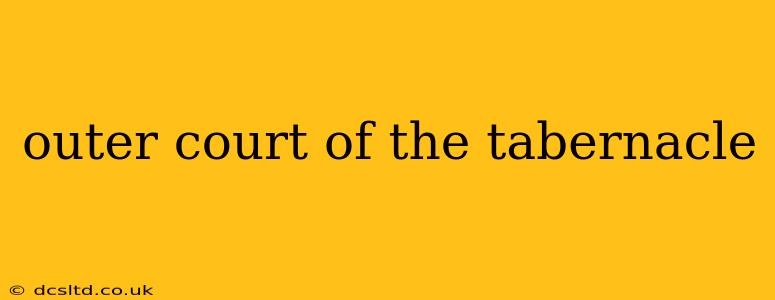The tabernacle, a portable sanctuary described in the Book of Exodus, served as the dwelling place of God among the Israelites during their journey through the wilderness. While the inner sanctum, the Holy of Holies, held the most sacred objects and symbolized God's ultimate presence, the outer court played a vital, often overlooked, role in the worship and daily life of the Israelite community. Understanding the outer court reveals crucial aspects of their faith and relationship with God.
What was the purpose of the outer court of the tabernacle?
The outer court served as a transitional space, a liminal area between the everyday world and the sacred presence of God. It was a place of preparation, cleansing, and community, where the Israelites could approach God in a structured and reverent manner. It was not merely a physical enclosure but a symbolic representation of God's relationship with his people.
What was located in the outer court of the tabernacle?
The most prominent features of the outer court were:
- The Bronze Altar: This was the central focal point, where animal sacrifices were offered to atone for sins and to maintain a right relationship with God. The altar's location in the outer court emphasized the importance of atonement before approaching God's immediate presence.
- The Laver: Located near the entrance to the Tent of Meeting (the inner sanctuary), the laver was a large basin filled with water used by the priests to wash their hands and feet before entering the Holy Place. This symbolized ritual purity and the necessity of cleansing before encountering the sacred.
What were the dimensions of the outer court of the tabernacle?
The outer court was a rectangular enclosure, 100 cubits long and 50 cubits wide (approximately 150 feet by 75 feet). This spacious area accommodated not only the altar and laver but also allowed for a considerable gathering of the Israelites during worship and sacrificial ceremonies. The size reflects the importance of communal worship and the accessibility of God's presence to the entire congregation.
How did the outer court relate to the inner sanctuary?
The outer court acted as a buffer zone, separating the everyday world from the holiness of the Tent of Meeting (which contained the Holy Place and the Holy of Holies). Access to the inner sanctuary was strictly controlled, reserved only for the priests, further emphasizing the sanctity of God's presence. The outer court, therefore, served as a necessary preparation for approaching God's more immediate presence.
What were the materials used to construct the outer court?
The outer court was enclosed by linen curtains supported by pillars of acacia wood overlaid with bronze. This combination of materials—linen representing purity and bronze representing strength and judgment—highlighted the importance of both moral purity and God's justice in approaching him. The use of bronze also symbolized the divine judgment that accompanied sacrifice and atonement.
What is the significance of the outer court of the tabernacle?
The outer court of the tabernacle holds deep theological significance. It represents the accessibility of God while simultaneously underscoring the need for proper preparation and reverence. It's a visual representation of the journey towards God, highlighting the necessity of cleansing, atonement, and communal worship in the process. It reminds us that while God's presence is accessible, it demands respect and a sincere effort to align ourselves with his will. The outer court is not simply a physical space; it is a powerful symbol of God’s relationship with His people, emphasizing grace, judgment, and the process of sanctification.
